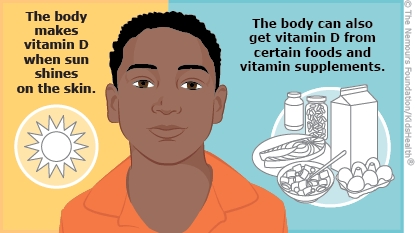Vitamin D Deficiency: How to Care for Your Child
Vitamin D is a key nutrient for strong bones and overall health. We get it from the foods we eat, and our bodies also make it when skin is exposed to sunshine.
Vitamin D deficiency is when there's not enough vitamin D in the body. It's treated by increasing the amount of vitamin D in the diet and/or taking supplements by mouth. Sometimes, health care providers recommend letting kids over 6 months old safely expose their skin to sunshine for brief periods.


-
Give vitamin D and any other supplements as recommended by your health care provider.
-
Help your child get enough vitamin D:
-
Babies younger than 1 year old need 400 IU of vitamin D a day. Baby formula has 400 IU per liter, so babies who drink at least 32 ounces of formula each day get enough. Babies who drink only breast milk or less than 32 ounces of formula each day need to take a vitamin D liquid supplement.
-
Kids older than 1 year need 600 IU or more of vitamin D a day. Give at least 3 servings of foods rich in vitamin D a day. It can be hard for most kids to get enough vitamin D from the foods that contain vitamin D naturally (such as salmon, tuna, liver, mushrooms, eggs, and fish oils). But many foods have vitamin D added to them, such as milk, yogurt, baby formula, juice, and cereal. Read the food labels to make sure your child gets enough vitamin D every day.
-
Kids also get vitamin D from the sun. If your health care provider says it's OK, your child can be in the sun for 10–15 minutes a few times a week without sunscreen. For longer periods, be sure to protect your child's skin with sunscreen, clothing, and shade. There is a risk for skin cancer later in life if your child gets too much sun.
-
Physical activity helps with bone health:
-
Help your child get at least 1 hour of physical activity each day. Activities that help build strong bones best include weight-bearing activities like walking, running, climbing stairs, jumping, and weightlifting.
-
No smoking:
-
Along with its many other health risks, smoking weakens bones. Your child should not smoke, and no one should smoke around them. If you or someone in your household needs help quitting, call 800-QUIT-NOW or visit smokefree.gov.
-
Follow up as instructed by your health care provider.

Your child:
-
isn't taking the prescribed vitamin D
-
has signs of severe vitamin D deficiency, such as muscle or bone pain (babies and very young children may just be extra fussy) or not learning to stand and walk like other kids their age

What does vitamin D do? Vitamin D helps the body absorb calcium and phosphorous, two of the basic building blocks of bone. Vitamin D also plays a part in heart health, fighting infection, and helping bones heal after an injury or surgery.
What causes vitamin D deficiency? Vitamin D deficiency can happen in kids who don't get enough vitamin D in their diet, get very little sunlight, have kidney or liver disease, are obese, or have conditions or take medicines that prevent their bodies from absorbing enough vitamin D.
What are the symptoms of vitamin D deficiency? Some kids with vitamin D deficiency (especially if they haven't had it for a long time) don't have any symptoms. When symptoms do happen, they depend on how old the child is. Vitamin D deficiency in babies and children can lead to rickets. Kids with rickets have soft, weak bones. As the bones grow, they can become misshapen and lead to problems such as bone pain and slowed motor (standing, walking) development.
If older kids and teens (whose bones are fully developed) don't get enough vitamin D, their bones can become soft and weak and be more likely to break.